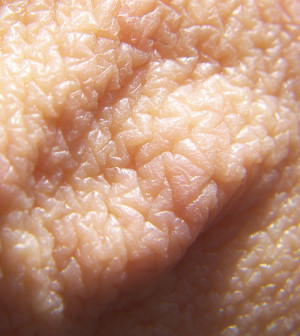- Navigating Your Midlife Crisis: Embracing New Possibilities
- City Raccoons Showing Signs of Domestication
- Mapping the Exposome: Science Broadens Focus to Environmental Disease Triggers
- One Week Less on Social Media Linked to Better Mental Health
- Your Brain Changes in Stages as You Age, Study Finds
- Some Suicide Victims Show No Typical Warning Signs, Study Finds
- ByHeart Formula Faces Lawsuits After Babies Sickened With Botulism
- Switch to Vegan Diet Could Cut Your Greenhouse Gas Emissions in Half
- Regular Bedtime Does Wonders for Blood Pressure
- Dining Alone Could Mean Worse Nutrition for Seniors
Indoor Tanning Ups Melanoma Risk, Even Without Burning: Study


Many Americans visit tanning salons this time of year, hoping that a little “base” color might prevent a full-blown beachside burn.
But even without getting a sunburn, indoor tanners boost their risk for melanoma, the deadliest form of skin cancer, a new study finds.
“The bottom-line is that tanning is a biological response to damage to the DNA,” study co-author DeAnn Lazovich said. “And you’re going to get that [ultraviolet light] damage in a tanning booth whether or not you burn.”
The study involved roughly 1,800 people, half with melanoma and half without, none of whom had ever suffered a burn while tanning indoors.
By focusing on those who said they never had a sunburn, the study team determined that melanoma patients were nearly four times more likely to have used tanning beds than those who were cancer-free.
About 68,000 new cases of melanoma are diagnosed in the United States each year, according to the U.S. National Institutes of Health. Disease risk rises with increased exposure to ultraviolet (UV) radiation, whether from the sun or a sunlamp, experts warn.
“It’s certainly often the case that people tan indoors specifically to prevent getting a sunburn,” said Lazovich, an associate professor in the school of public health at the University of Minnesota in Minneapolis. “I do think it’s often implied that they are doing something to reduce the risk to their health.”
The researchers set out to test the theory that indoor tanning without burning might lower melanoma risk. Instead, they found the opposite was true.
The study, published in the May 29 issue of the Journal of the National Cancer Institute, looked at about 900 melanoma patients diagnosed between 2004 and 2007 at ages ranging from 25 to 59. The researchers compared them with about 900 healthy men and women.
The study was restricted to people who had either tanned indoors without burning or who had no prior history of indoor tanning.
All participants answered questions concerning family history of skin cancer, income and education, sunscreen habits, lifetime outdoor sun exposure and physical characteristics such as freckle distribution, and skin and eye color.
Overall, nearly 57 percent of the participants said they had experienced five or more outdoor sunburns in their lifetime. Only about 5 percent said they had never had a sunburn, the researchers noted.
Melanoma patients who said they had never had a sunburn were found to have used tanning salons at a younger age and more often than those who had been sunburned at some point, the study authors found.
“Basically, there is no safe way to tan,” said Lazovich. “Sun protection and avoidance of ultraviolet radiation in any form should be the goal.”
Dr. Jennifer Stein, an assistant professor in the department of dermatology at NYU Langone Medical Center in New York City, agreed.
“Indoor tanning has really high amounts of ultraviolet light that damages the skin and really increases your risk for skin cancer,” she explained.
Melanoma can be deadly, if not detected early, Stein added. “Preventing people from using indoor tanning beds is a very important message, particularly for young people,” she said.
Because it’s hard to get the message across, she noted that it helps to mention that indoor tanning really wrinkles the skin. “It’s a cosmetic point of view that may help get people’s attention. But the point is the same: Indoor tanning is not good for your skin,” she said.
The U.S. National Cancer Institute also advises against any form of indoor tanning.
More information
For more about melanoma, visit the U.S. National Cancer Institute.
Source: HealthDay
Copyright © 2025 HealthDay. All rights reserved.










